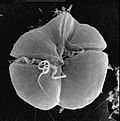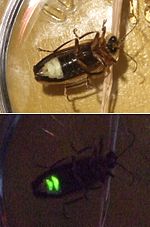Dinocyst (redirect from Dinoflagellate cyst) Dinocysts or dinoflagellate cysts are typically 15 to 100 µm in diameter and produced by around 15–20% [citation needed]of living dinoflagellates as a dormant... 87 KB (9,312 words) - 20:44, 6 March 2024 |
 | Bioluminescence (redirect from Dinoflagellate light production) The most frequently encountered bioluminescent organisms may be the dinoflagellates in the surface layers of the sea, which are responsible for the sparkling... 74 KB (8,010 words) - 17:22, 25 April 2024 |
 | Luciferase (section Dinoflagellate) examples in other kingdoms including bioluminescent bacteria, and dinoflagellates. The luciferases of fireflies – of which there are over 2000 species... 27 KB (2,896 words) - 13:08, 29 March 2024 |
Dinoflagellate Blooms is the fourth studio album that J. G. Thirlwell has issued under the pseudonym Manorexia. It was released on June 11, 2011 by Ectopic... 3 KB (113 words) - 03:56, 13 January 2021 |
 | named for Dr. Karen Steidinger for her exceptional contributions to dinoflagellate research. She has spent many decades researching Karenia brevis. 12... 12 KB (1,488 words) - 01:18, 13 March 2024 |
Calcareous dinoflagellate cysts or calcareous dinocysts are dinoflagellate cysts produced by a group of peridinoid dinoflagellates, called calcareous... 6 KB (720 words) - 02:33, 16 May 2023 |
Dinoflagellate/viral nucleoproteins (DVNPs) are a family of positively-charged, DNA-binding nucleoproteins found exclusively in dinoflagellates and Nucleocytoviricota... 2 KB (281 words) - 19:40, 3 December 2023 |
 | (e.g. Shewanella hanedai and Shewanella woodyi) Protists Certain Dinoflagellates (e.g. Noctiluca scintillans, Pyrodinium bahamense, Pyrocystis fusiformis... 9 KB (521 words) - 22:03, 10 April 2024 |
 | unicellular species of green algae, many golden algae, euglenids, dinoflagellates, and other algae have become heterotrophs (also called colorless or... 90 KB (10,420 words) - 08:58, 3 April 2024 |
 | Zooplankton (section Dinoflagellates) zooplankton, including zooflagellates, foraminiferans, radiolarians, some dinoflagellates and marine microanimals. Macroscopic zooplankton include pelagic cnidarians... 76 KB (7,030 words) - 20:45, 10 April 2024 |
 | Bacterial DNA binding protein (redirect from Dinoflagellate histone-like proteins) group of eukaryotes known as dinoflagellates. These dinoflagellate histone-like proteins replace histone in some dinoflagellates and package DNA into a liquid-crystalline... 19 KB (2,263 words) - 01:58, 11 December 2023 |
 | Scintillon (section Dinoflagellate light production) produce light. Among bioluminescent organisms, only dinoflagellates have scintillons. Marine dinoflagellates at night can emit blue light by bioluminescence... 10 KB (1,282 words) - 12:41, 7 January 2023 |
remains from the Eocene of Barbados can be interpreted as dinoflagellate thecae of the dinoflagellate Peridinites. These have previously been interpreted as... 614 bytes (66 words) - 17:22, 12 February 2017 |
 | Symbiodinium (category Dinoflagellate genera) Symbiodinium is a genus of dinoflagellates that encompasses the largest and most prevalent group of endosymbiotic dinoflagellates known and have photosymbiotic... 72 KB (7,408 words) - 04:59, 18 March 2024 |
 | Gonyaulacales (category Dinoflagellate orders) Gonyaulacales is an order of dinoflagellates found in marine environments. Taylor, FJR (1980). "On dinoflagellate evolution". BioSystems. 13 (1–2): 65–108... 1 KB (54 words) - 00:54, 13 March 2024 |
 | Gyrodinium (category Dinoflagellate genera) Gyrodinium is a genus of dinoflagellates belonging to the order Gymnodiniales within class Dinophyceae. The genus has cosmopolitan distribution. World... 5 KB (366 words) - 01:10, 13 March 2024 |
 | Ceratium (category Dinoflagellate genera) (about 7) of freshwater dinoflagellate species. Previously the genus contained also a large number of marine dinoflagellate species. However, these marine... 14 KB (1,465 words) - 00:58, 13 March 2024 |
 | For example, Gymnodinium nagasakiense can cause harmful red tides, dinoflagellates Gonyaulax polygramma can cause oxygen depletion and result in large... 29 KB (3,353 words) - 05:38, 22 April 2024 |
 | transferring plastids to ochrophyta (e.g. diatoms, brown algae), dinoflagellates, cryptophyta, haptophyta, and euglenids (the events may have begun... 172 KB (9,395 words) - 04:29, 22 April 2024 |
 | Luciferin (section Dinoflagellate) blue light emission. Dinoflagellate luciferin is a chlorophyll derivative (i. e. a tetrapyrrole) and is found in some dinoflagellates, which are often responsible... 9 KB (867 words) - 20:20, 25 April 2024 |









